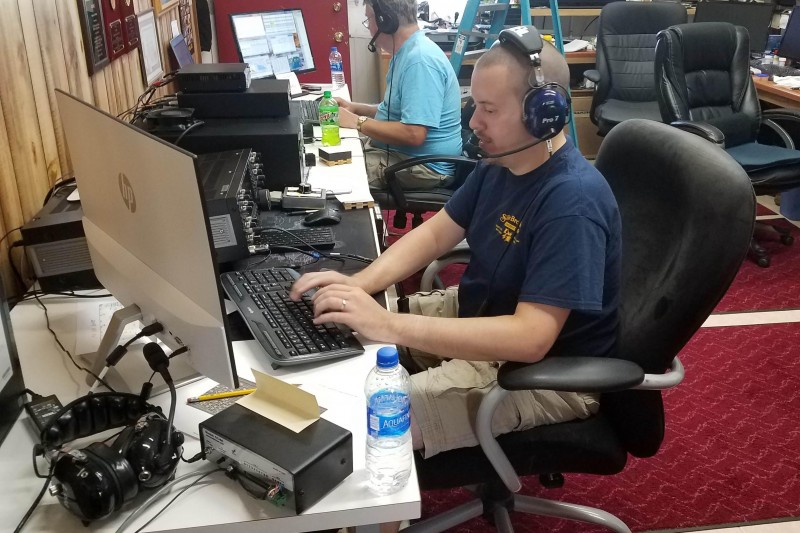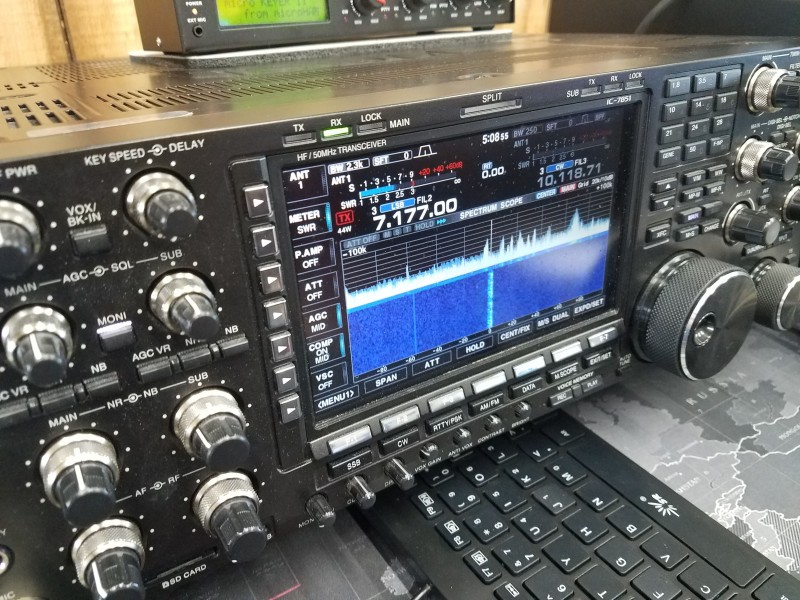One of the special features IARU HF Championship contest is bonus points for contacting the headquarters stations for each of the IARU member societies. The International Amateur Radio Union (IARU) itself also counts as one of these stations. While the Union does not maintain their own station, the privilege to operate their NU1AW call sign is awarded to different contest stations each year. WB9Z and K9CT were chosen this year to operate SSB and CW respectively. These stations are expected to work on multiple bands simultaneously to maximize the number of contest participants that can get these bonus points. This requires a team of operators.
Matt AC9IG was asked to be part of the SSB team hosted by Jerry WB9Z and Val NV9L in Crescent City, IL. He answered a few questions for us regarding operating in this contest.

How did the station differ from your setup at home?
The station at WB9Z is set up for three radios to operate simultaneously. Each one has an amplifier capable of 1500W as well as a high-end radio that really helps to pull out call signs and exchanges in crowded band conditions. The radios each have access to an array of antennas for all bands. Some of these rotate, others are oriented in different fixed directions to take advantage of the gain they provide to different continents for DX. At home I have a dipole that propagates east-west and a 100W transceiver.
Each radio is also attached to a computer to facilitate logging. This is similar to my home station, however we took advantage of having three logs available to us by networking the computers. This once a station was in any log the contest exchange (in this case an ITU zone) would automatically be looked up by any other station completing a part of the log for you automatically.
With the contest station the goal is to get as many contacts as possible. There are a few features of the station that help this. A high quality set of headphones nearly cuts out all noise from the room so you can focus on the audio from the radio. With three stations operating in the same room this is very helpful. The headphones also have a microphone attached so there is no need to pick up a hand mic leaving your hands free to enter call signs into the computer. To complete keeping your hands on the keyboard, the push to talk switch is actually a foot pedal. It takes a few minutes to get used to this setup.
Compare operating in a contest from your home station to the IARU experience.
At home I typically operate search and pounce. That is I will tune the radio until I find a station then contact that station before moving on to find another station. On a really good day I might be able to get 1-2 contacts per minute, but only for a few minutes at a time.
With the hands free radio arrangement you can easily “run” a frequently make 3-4 contacts per minute for extended periods of time. You begin by finding an open frequency. It also helps to study what stations you hear on the band and select an antenna that is pointed towards those stations that you are hearing. This will change throughout the day. Once you’ve found an open frequency you begin calling CQ. With any luck you’ll have people begin responding to you in a few minutes.
It gets very interesting when your station is “spotted,” or more specifically when your frequency and call sign are posted on the internet. Many operators monitor these web sites and jump right to new stations as they appear. You’ll recognize when this happens because you’ll suddenly have an [audio] wall of call signs being sent your way between each contact. With a little bit of practice you can begin to pick out one call sign from this blob of noise. Frequently you’ll only hear a portion of the call sign, and you’ll find yourself asking something like “the alpha charlie station again” to get the rest of the call sign.
Finally, the call sign we were operating under, “NU1AW/9” and the exchange we sent “IARU” have fairly long phonetics. A recording of “November United One Alpha Wiskey portable Nine” was stored in the radio and could be sent with just a single key press helping to save your voice. I’m able to do this at my home station as well, so this part of the process was fairly seamless for me. The “India Alpha Radio United” zone that were gave as part of our exchange caught many stations off guard as they were expecting a number representing our zone, so an explanation was frequently required.

Is there anything you would have done differently?
I would have taken more time to learn the equipment that I was working with. There are a lot of very advanced features that help to pull a very weak station out of the noise. Some of these I was familiar with, but the buttons or knobs that control them were in different places than the radio at my home station. I might know that I wanted to use a narrower bandwidth to hear a station, but I had to search for this knob the first few times that I needed to use it. Separately, there are plenty of other features that I was completely unfamiliar with so I was unable to make the most of the equipment in front of me.
What did you learn from contesting in this way?
While having a great radio, amplifier and plenty of antenna choices helps, the skill of the operator to be able to hear call signs in the noise or to pick one call sign out of 10 is a huge part of contesting.
From this I can offer the advice for those of us operating at home… Listen, then call. If you can hear him there’s a very good chance he can hear you, and there’s a very good chance he has some or all of the equipment described above which will help him to hear your call sign quickly and easily. Once you understand this you really have no reason not to try and call any station that you hear. I’ll be doing this myself for the next contest that I operate from home.
Overall, how did the contest go?
Combined the CW and SSB teams totaled 18 operators and made contacts with just under 7400 stations in a 24 hour period. Being one of the headquarters stations, however, means that we were not actually competing in the contest.
What was your favorite part of this opportunity?
The chance to work with other contest operators was amazing. I was able to learn plenty of tips and tricks for working pileups. And it was a lot of fun to share ham radio storied with these guys when we weren’t on the air.